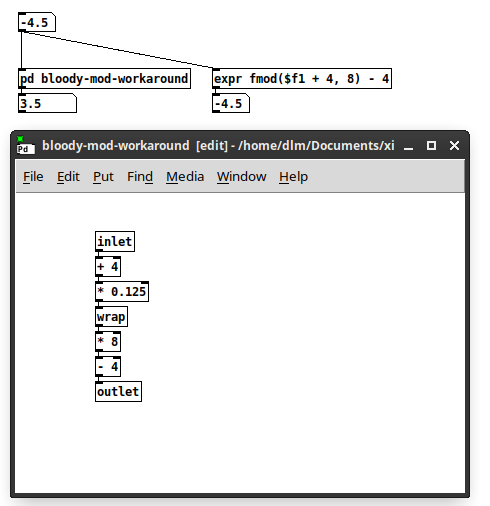-
ddw_music
posted in technical issues • read more@jamcultur said:
If the code on Windows was the same as the code on Mac, they would work the same.
One source of confusion here is the difference between source and object code.
Most of the time, humans never look at the object code produced by a compiler. We only look at the source code. So, when porres says there's no difference in the code between platforms, this is talking about source code.
The source code gets compiled into object code. In Mac vs Windows, the compilers are different, and the CPUs (architectures and instruction sets) are different. If the Mac is using an M-series CPU, then it's impossible for the object code to be the same as Windows (Intel or AMD chip), because the instruction sets are completely different. (That's also not considering the differences in OS function calls, which of course will not be the same between different OSes.) So in fact, "the code" isn't the same -- but this isn't porres's fault, and there's no way for the code not to be different.
Ideally, the same source code compiled for different chips should produce equivalent results. Programmers usually take this as a safe assumption. But there are edge cases where it might not work out that way (we just saw one of those over in SC-land, related to floating-point rounding). These cases can be extremely difficult to debug, and at the end of the day, one is at the mercy of the CPU and the compiler's behavior.
In such cases, it isn't helpful to accuse a developer of writing different code for Windows (this is implausible for DSP code in any case, which is mostly math operations that are well abstracted -- you don't need #ifdefs for std::xxx() math functions) or of "not caring" enough.
We want to assume that the compiler and CPU are transparent with respect to the source code's meaning. When that isn't the case, it's necessary to inspect every operation. It's painful, and if porres doesn't have access to a machine where the problem occurs, it can be very slow (test builds, relying on other people to run the specific tests). A little patience goes a long way.
hjh
-
ddw_music
posted in technical issues • read more@porres said:
cyclone does not have a [spectrogram~] object
ELSE has [spectrograpg~] though.
Thanks -- I didn't look closely enough at the help patch.
About formant synthesis with FM, I know Miller includes something like that in the audio examples (see F10). Is it related maybe?
It probably is, and his implementation is probably more elegant than mine (though it's jammed into a small space on the screen so it's a bit tough for me to read quickly).
It takes some tuning -- the FM index isn't a simple analog to formant bandwidth (it seems to need to be scaled down at higher pitches). But it's computationally cheap and gets a useful result, and it seemed to fit "approaches to formants other than bandpass filtering."
hjh
-
ddw_music
posted in technical issues • read moreThere's also the John Chowning "Phoné" FM formant approach, where the carrier is at the formant center frequency and the modulator is at the fundamental. It's "formant-ish" I suppose, but sweeping the fundamental while holding the formant frequency steady does produce a vocal-ish sound.
Here I'm crossfading between two formants, to make smooth transitions between integer carrier-mod frequency ratios.
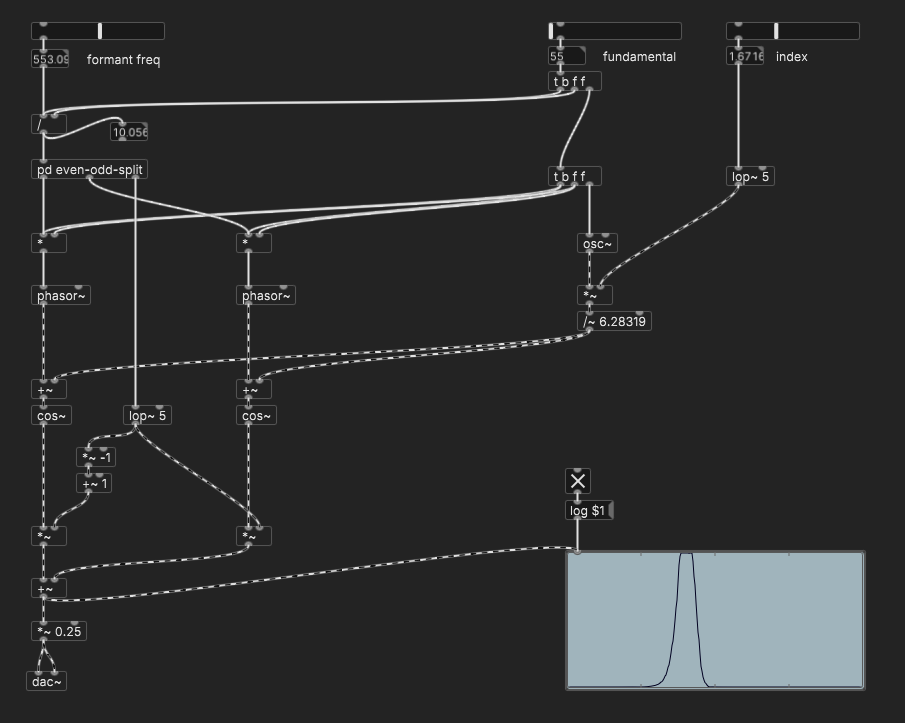
Oops, no:
(~[spectrogram~] is from cyclone -- not essential to the patch's operation.)(~[spectrograph~] is from ELSE -- not essential to the patch's operation.)
hjh
-
ddw_music
posted in technical issues • read more@willblackhurst Tilde objects don't have anything to do with voltage inside the computer.
hjh
-
ddw_music
posted in technical issues • read moreInteresting that both responses assumed that atux wants to send pitch bend messages out, but "modulate the pitch in real time by moving a slider" says nothing about MIDI being the target.
The question might just as easily be, "How to map a slider onto a frequency ratio, to multiply with the note's main frequency?"
Normalize the slider value. Because pitch bend normally goes both up and down, I normalize to -1 .. +1.
line~ for smoothing. (Also, I'm stealing the mouse-release logic from porres, good tip!)
Pitch bend range is given in semitones. We need a fraction of an octave = pbrange / 12.
Scale the normalized pb value onto the fraction of the octave = [*~].
The ratio for one octave = 2. So, the ratio for the fraction of the octave = 2 ^ fraction.
Now you have a ratio that you can multiply by any frequency, and get pb.
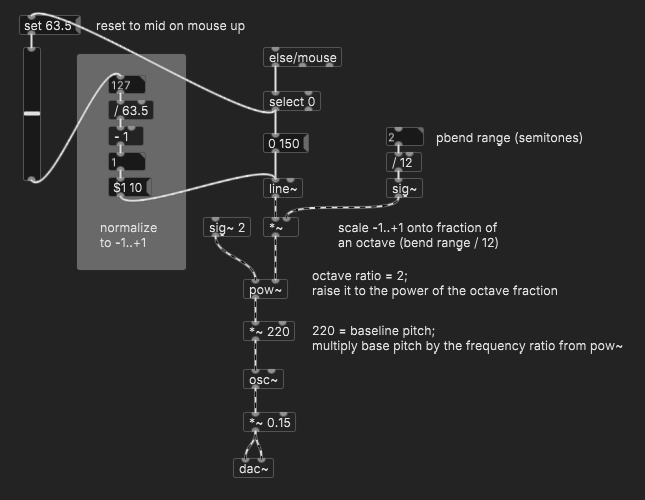
(More generally, almost any kind of exponential modulation i.e. frequency can be expressed as
baselineValue * (modRatio ** modulator). Pitch bend is a specific case of this, where modRatio = 2 and the modulator is scaled to the range +-pbrange / 12. Linear modulation just demotes the math ops:baselineValue + (modFactor * modulator). With these 2 formulas you can handle a large majority of modulation scenarios.)hjh
-
ddw_music
posted in technical issues • read more@fer FWIW this is a formula I've used for abstraction init defaults for awhile now -- only vanilla objects, no externals needed.

If the usage of the object is [defaults-test] with no args specified, it prints
abstraction_defaults: list default symbols 0 1 2 3= the values that I put into the [pack].If it's [defaults-test xyz ttt 34 72], then it prints
abstraction_defaults: list xyz ttt 34 72 2 3where the 4 values overwrote the [pack] values from the start... generally what you'd assume from defaults.(If all the args are numbers, then you don't need any funny business, just [pdcontrol] --> [pack].)
hjh
-
ddw_music
posted in technical issues • read moreyou did spread misinformation about it
So just correct it and move on.
When people try to reinvent what already exists... I built this for the community. Ignoring existing tools and efforts misses the spirit of open source
Both Pd and SC have a systemic problem wherein there is no good way for new users to know which extensions exist. Recent versions of Deken improve the situation somewhat for Pd, and there's a similar effort underway for SC, but "missing the spirit of open source" is quite a burden to lay on somebody who might have using the tool for just a couple of weeks or months.
So I'm out of this thread. I like a lot of the stuff in else, really, and I wish I'd known about it from the start. (Btw "when it's there in plugdata already" -- when I started using Pd in classes, there was no plugdata and there was no pd-extended, and no way to discover ELSE by chance.)
hjh
-
ddw_music
posted in technical issues • read more@porres said:
nah, I'll just leave as it is, the object is already too much complicated and I don't know how to deal with it (if anyone has a suggestion, please let me know).
Maybe like this? Instead of velocity --> envelope, derive a gate by way of [change]. Then multiply the envelope by the velocity value. The volume will change if the velocity changes on a slurred note. If you don't want that, it should be possible to close the spigot when slurring to a note, and open it only when a brand-new note is being played.

hjh
-
ddw_music
posted in technical issues • read more@porres said:
As for the discussion, if my objects are not working as expected, or if you have suggestions, you can open reports and requests.
OK, sure.
FWIW, I had developed my own methodology for this some years ago. At that time, I didn't know that [else/mono] existed.
I was just sharing a way to handle this problem that worked for me. My intention wasn't to raise shortcomings with your library -- it was only, "this is how I do it."
hjh
-
ddw_music
posted in technical issues • read more@porres said:
well, [else/mono] has a built-in portamento... and I don;t know what is wrong with it or how it works with [else/adsr~] for you...
I'm also sensing an unnecessarily punchy tone here. I won't engage with this.
hjh
-
ddw_music
posted in technical issues • read more@leonardopiuu said:
I began using plugdata a couple days ago and I'm making a simple mono synth
Mono synths are not simple! lol
MIDI's way of representing keyboard activity is not exactly convenient for mono use. So, I'm going to guess that the velocity and/or ADSR behavior is the result of a logic problem before reaching the ADSR.
Especially based on this comment: "BUT the velocity isn't sent out from the pack unless I press at least TWO keys at the same time..."
It's tricky. This was my solution, in the midimonoglide.pd abstraction:
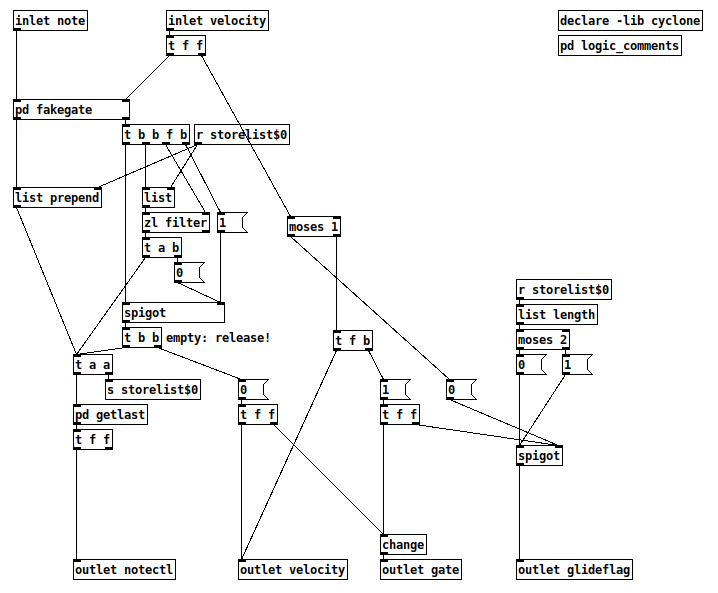
Confused? Yeah. MIDI-to-mono logic is complicated enough that it will probably take you more than a couple of days of plugdata usage to really grasp it. There's no such thing as a "simple MIDI mono synth."
So I'd suggest to use either [else/mono] -- you already have ELSE lib, so, nothing else to install -- or my abstraction (which helps with mono note glide -- but you might not need that at this point.
Then, when you have properly cleaned up and filtered MIDI data, then the ADSR "should" be the easy part.
The ELSE way -- note here that every note-on sends out a non-zero velocity, so the envelope will retrigger repeatedly. I'm not crazy about that behavior, but it might be OK for your use case (and the patch is simpler).
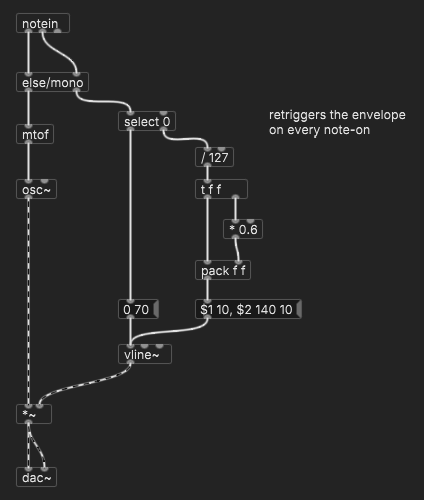
The hjh way -- where it becomes possible to distinguish between sliding, non-retriggering notes and genuinely new notes. (The [noteglide] isn't strictly necessary -- but, IMO fingered portamento is the whole point of a MIDI monosynth
 so I'm using it.)
so I'm using it.)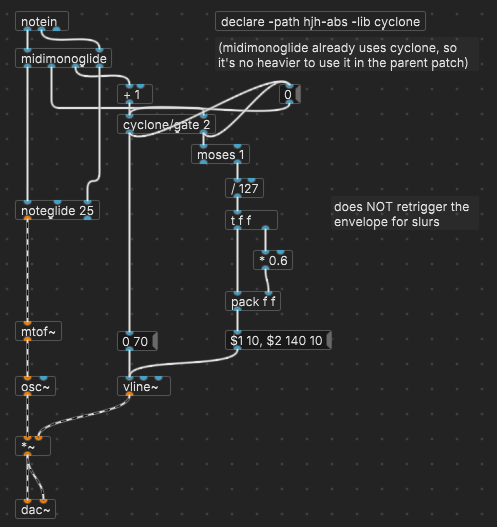
Hope this helps -- and no worries. If you made this much progress in Pd in a couple days, to the point where you run into the not-at-all obvious subtleties of MIDI mono handling, that's pretty good.
hjh
-
ddw_music
posted in output~ • read moreFinally posted video from my electronic ensemble class's concert last June. Pd didn't figure into the audio side, but 2 out of 3 pieces used Gem for the graphical backdrop.
It was a fun night, hope you enjoy!
Link goes directly to the third piece; the playlist includes the other two.
hjh
-
ddw_music
posted in output~ • read moreHere's a short clip of an interactive installation piece (I guess more of a prototype?) that was shown last weekend.
- Audio: SuperCollider (+ VSTPlugin for the piano and guzheng)
- Graphics: Pure Data + Gem
- UI: Open Stage Control (with heavy CSS gradient abuse
 -- iPad batteries really don't like rendering 13-14 new gradients, 9 times per second)
-- iPad batteries really don't like rendering 13-14 new gradients, 9 times per second)
Musical decisions are made by flipping bits in a 40-bit word, and mapping various segments of the bits onto sequencing parameters.
At some point, I'd like to do an explainer video, but not today.
hjh
-
-
ddw_music
posted in technical issues • read more@jameslo said:
@whale-av My issue is (was?) that there are things that affect the DSP sort order that you can't see from the graphics alone. As far as I understand, that's different from @ddw_music's question, which is "how much of the DSP graph does Pd have to resort when there's a change"? That said, I don't understand the reason that @spacechild1 gave on the mailing list--I'd love to see an example.
Well, here's what he said: "The issue is that DSP objects can be 'connected' by other means. Take the delay objects, for example. Some of these objects need to be aware of the order of execution within the DSP graph. Others will affect other objects, e.g. automatically changing the channel count. Pd itself doesn't know what a particular ugen is doing, so the only thing it can do is rebuild the whole graph."
@whale-av Yes, I'm writing a paper, but the paper isn't about Pd graph sorting -- this is a side point -- the latency thread is interesting but would be way too much detail for basically a footnote.
hjh
-
ddw_music
posted in technical issues • read morePer spacechild1 on the mailing list: Yes, it does sort all dsp objects in all canvases, every time (because they may have invisible connections, like delay objects or send~ / receive~ / throw~ / catch~).
hjh
-
ddw_music
posted in technical issues • read more@jameslo said:
@ddw_music If Pd's topological sort algorithm were smart enough to know when a change inside an abstraction did not change the sort outside the abstraction, then it would be an easy lift for it to detect that feedback to some abstraction (e.g. one with an [inlet~], an [outlet~], and no connections) does not produce a cycle. But the last I checked, that was not the case, so I would bet that when anything changes, the whole directed graph is resorted.
I guess the issue, then, is, if all the tilde objects get lifted into one flat list, then a change inside a subcanvas could get inserted in the midst of objects outside the canvas. In that case, it probably is necessary to walk the entire tree.
In the video, he starts off the sorting section by saying that canvases tell the DSP layer what has changed locally within the canvas, but then discusses the sorting flow when DSP gets turned on (which obviously has to start at the topmost canvas).
And then in g_canvas.c there are comments like
/* create a new "DSP graph" object to use in sorting this canvas. If we aren't toplevel, there are already other dspcontexts around. */so the data structure does seem to be split up by canvases.
It's not a crucial point -- just that, I'm expending a paper and wanted to contrast SC's per-SynthDef graph sorting vs Pd's seemingly global sorting. I'd rather not make a false claim.
Mailing list, I guess.
hjh
-
ddw_music
posted in technical issues • read more@lacuna said:
Maybe the answer is in this video of Millers classes at 1:04:00
OK, will have a look, thanks!
hjh
-
ddw_music
posted in technical issues • read moreI always had the impression that Pd reschedules and re-sorts all DSP objects in the system globally whenever a change is made... is that true?
Wondering because I could also imagine that subpatches or abstractions could reduce the scope of the DSP design that has to be analyzed at any moment.
That is, if I'm in a subpatch and I make or delete a DSP connection, in theory it could just re-sort the DSP defined within the subpatch, but internally it might just redo everything anyway.
Purely a matter of curiosity. I don't have a concrete use case.
Thanks,
hjh -
ddw_music
posted in abstract~ • read more@jameslo said:
FYI, an algorithm I was taught in school uses a heap-based priority queue for that B array.
Oh nice, I overlooked that one... the limitations of having zero formal training in CS. I actually have a pure vanilla float-heap abstraction already (https://github.com/jamshark70/hjh-abs)... lower values to the top. For descending order, I'd just negate on the way in and out.
hjh

